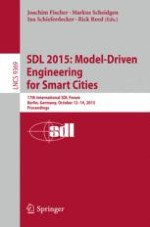2015 | Book
SDL 2015: Model-Driven Engineering for Smart Cities
17th International SDL Forum, Berlin, Germany, October 12-14, 2015, Proceedings
Editors: Joachim Fischer, Markus Scheidgen, Ina Schieferdecker, Rick Reed
Publisher: Springer International Publishing
Book Series : Lecture Notes in Computer Science
